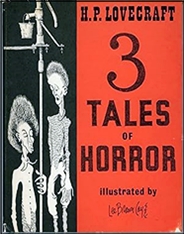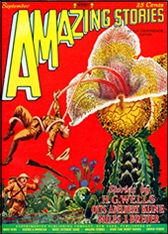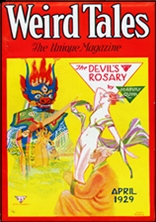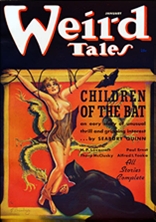Sat 20 Jul 2024
Reviewed by Tony Baer: H. P. LOVECRAFT – 3 Tales of Horror.
Posted by Steve under Pulp Fiction , Reviews , Science Fiction & Fantasy[5] Comments
H. P. LOVECRAFT – 3 Tales of Horror. Arkham House, hardcover, 1967.
So I’ve had this really cool edition of Lovecraft from August Derleth’s Arkham House, with ominous illustrations by Lee Brown Coye. Take a look here, using the link below, and you’ll get the general idea: https://dangerousminds.net/comments/the_dark_art_of_h.p._lovecraft_illustrator_lee_brown_coye.

But for whatever reason I’d never read it. Nor any Lovecraft. Now back in my D&D’ing days of yore (Dungeons and Dragons, for the uninitiated), I became somewhat familiar with and frightened by Cthulhu. But that’s where my acquaintance stopped.
Whether because of my general disdain for the horror genre, or due to Lovecraft’s reputation for racism and lack of stylistic panache — or even prosaic competence — I had hitherto avoided reading any. But upon crackling open the spine of this here volume, hither and thither hast my avoidance been vanquished.
In other words, Lovecraft is freaking awesome! I loved these three stories. They’re great and I devoured them as quick as I could before they could devour me.
The three stories were:

1. “The Colour Out of Space.” Amazing Stories, September 1927.
In this one, some weird meteor hits near a farm house, west of Arkham, New England way, near Miskatonic University.
The material of the ‘meteor’ is of some hitherto unknown quality that appears on no periodic table of this realm.
The scientists are all excited to test a piece of it. But as they test it, it starts to shrink, then disappear.
Finally they chip into the thing itself, deeply, releasing some amorphous blue globule. Nothing to see here. All is well. It continues to shrink, then disappear, til near forgotten.
Then the farmer and his family start to grow gorgeous but inedible crops , and they begin to act crazier and crazier, and finally disappear one by one.
There is something corrupt in the soil, in their wellspring. And it’s spreading.

2. “The Dunwich Horror.” Weird Tales, April 1929.
Young Wilbur Whately is born in Dunwich, child of weak-minded albino mother, and fathered by some monstrosity. Gramps is some sort of sorcerer called Old Whately.
Wilbur grows at an inhuman rate, able to walk around and read in multiple languages by the time he was a toddler, big as a 4 year old by 2, big as an 8 year old by 4. And so on.
Wilbur and gramps are working to conjure an ancient spirit to retake the earth and vanquish humanity. Will they get away with it? Tune in next time…..same bat time…..same bat channel.

3. “The Thing on the Doorstep.” Weird Tales, January 1937.
“It is true that I have sent six bullets through the head of my best friend, and yet I hope to show by this statement that I am not his murderer. At first I shall be called a madman — madder than the man I shot in his cell at the Arkham Sanitarium.”
And so it begins….
Our narrator has murdered a person who appears to be Edward Derby, his lifelong friend.
But the story tells the tale of Ephraim Waite — a mysterious man of whispered wizardry. And his Winona Ryder looking daughter Asenath who steals the heart of our beloved Mr. Derby, and they wed.
Mr. Derby’s soul seems increasingly to be wrenched from his body, and transported into the body of his strange bride, and vice versa. And there is a struggle for control of the body between each soul. A battle for the corpus of the man, Edward.
If Edward is killed whilst his body is possessed by Asenatha Waite—who then is the victim?
____
Anyway, I really dug these stories. Yeah, the prose is antiquated. But the style fits the mysterious boggy settings. And adds to them, really.
Another thing I liked about the stories is they are narrated in each case by a sceptic — a non-believer in magical spirits and alien powers. It is only by the ‘objective’ appearance of inexplicable happenings that the inherent skepticism is overcome. And you find yourself being slowly edged into belief, an objective observer of ineffable horrors.
July 20th, 2024 at 11:09 pm
For all his flaws Lovecraft weaves a spell unique among his fellow writers of horror and fantasy. These are among his best, and others well worth reading are AT THE MOUNTAINS OF MADNESS, “Pickman’s Model,” and “The Cats of Ulthar” to name a few.
Everything bad they say about HPL is true, but he also wrote mindblowing stories that imply the vastness and terror of the Universe and beyond like no one since Poe.
July 21st, 2024 at 7:55 am
I couldn’t make a steady diet of Lovecraft, no more than I could do of Poe–or Proust, Pynchon, and a dozen other geniuses I could name. And I can’t revisit him the way I can with Chandler, Hammett, Wodehouse, Fredric Brown….
But there’s no denying the man had his own special magic!
By the way, I have an old book, THE SORCERER’S APPRENTICE, by Hans Heinz Ewers, signed by H P Lovecraft!
Well, to be perfectly accurate, someone wrote “LOVECRAFT” with a pencil in awkward block letters, on one of the inside pages, but still….
July 21st, 2024 at 9:01 am
Lovecraft wasn’t completely out of the mainstream in 1963, when I first encountered him. THE DUNWICH HORROR, a Lancer paperback, sat on the spinner racks with Morris West, James Michener, and Mary McCarthy. But he was certainly obscure. I’m amazed to see so many of his collections on the shelves of the (vanishing) brick-and-mortar bookstores. The fact he’s largely PD has something to do with it, but that’s only a partial factor. All three of the stories in 3 TALES have been made into movies.
July 21st, 2024 at 4:02 pm
It’s interesting that someone wrote Lovecraft’s name on the Ewers book because Ewers was an influence on HPL. There are similarities between the two as far as their attitudes go. Ewers was a strong pro-German presence in the first half of the 20th century, and was most likely a German agent. He was quite taken with the Nazi philosophy but the two parted ways because Ewers was not a true anti-Semite and because Ewers was a homosexual (Lovecraft’s apparent lack of interest in sex has led some to believe that he may have had some homosexual tendencies); still, the Nazi connection has stayed with Ewers to this day. Lovecraft expressed strong xenophobic opinions much like Ewers, but with Lovecraft I suspect it was more of an affectation and a result of his upbringing rather than a true belief. Both can come across as bigoted, nationalistic (although HPL’s nationalism was for a time and place that never really existed), and unenlightened. Some people may tend to draw a stronger comparison between the two that may or may not be there.
July 21st, 2024 at 9:40 pm
Lovecraft’s flirtation with fascism ended in time for him to redeem himself a bit before the end as did Robert E. Howard’s (who HPL hoped change) and Sax Rohmer’s. He falls in that group that managed to open their eyes just in time to escape being completely tainted unlike Lindbergh and a few others who only dropped their activism when the War started.
HPL’s racism is more disturbing and obvious for readers today, but it is based in little actual knowledge or interaction with other races in this quiet isolated New England life. It has more to do with rather silly ideas about eugenics and race in general and some vague xenophobic beliefs about voodoo and such nonsense.
He comes across more as an unworldly aesthetic conjuring up boogeymen than a blatant racist, an unpleasant turn of mind more than an active racist.
Ewers, who penned the HORST WESSEL SONG, died in a concentration camp as did quite a few early supporters of Hitler including the man who inspired the Nazi’s interest in the Occult and ancient artifacts, both more for their being gay than any real disavowal of fascism or Hitler.